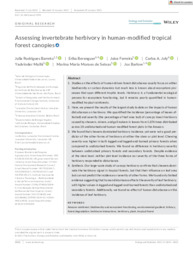Assessing invertebrate herbivory in human-modified tropical forest canopies.
Assessing invertebrate herbivory in human-modified tropical forest canopies.
Autoria: BARRETO, J. R.; BERENGUER, E.; FERREIRA, J. N.; JOLY, C. A.; MALHI, Y.; SEIXAS, M. M. M. de; BARLOW, J.
Resumo: Studies on the effects of human-driven forest disturbance usually focus on either biodiversity or carbon dynamics but much less is known about ecosystem pro-cesses that span different trophic levels. Herbivory is a fundamental ecological process for ecosystem functioning, but it remains poorly quantified in human- modified tropical rainforests. Here, we present the results of the largest study to date on the impacts of human disturbances on herbivory. We quantified the incidence (percentage of leaves af-fected) and severity (the percentage of leaf area lost) of canopy insect herbivory caused by chewers, miners, and gall makers in leaves from 1,076 trees distributed across 20 undisturbed and human- modified forest plots in the Amazon. We found that chewers dominated herbivory incidence, yet were not a good pre-dictor of the other forms of herbivory at either the stem or plot level. Chewing severity was higher in both logged and logged-and- burned primary forests when compared to undisturbed forests. We found no difference in herbivory severity between undisturbed primary forests and secondary forests. Despite evidence at the stem level, neither plot- level incidence nor severity of the three forms of herbivory responded to disturbance. Synthesis. Our large-scale study of canopy herbivory confirms that chewers domi-nate the herbivory signal in tropical forests, but that their influence on leaf area lost cannot predict the incidence or severity of other forms. We found only limited evidence suggesting that human disturbance affects the severity of leaf herbivory, with higher values in logged and logged-and- burned forests than undisturbed and secondary forests. Additionally, we found no effect of human disturbance on the incidence of leaf herbivory.
Ano de publicação: 2021
Tipo de publicação: Artigo de periódico
Unidade: Embrapa Amazônia Oriental
Palavras-chave: Biodiversidade, Ecossistema, Floresta, Floresta Tropical
Observações
1 - Por padrão são exibidas publicações dos últimos 20 anos. Para encontrar publicações mais antigas, configure o filtro ano de publicação, colocando o ano a partir do qual você deseja encontrar publicações. O filtro está na coluna da esquerda na busca acima.
2 - Para ler algumas publicações da Embrapa (apenas as que estão em formato ePub), é necessário ter, no celular ou computador, um desses softwares gratuitos. Sistemas Android: Google Play Livros; IOS: iBooks; Windows e Linux: software Calibre.
Acesse outras publicações
Acesse a Base de Dados da Pesquisa Agropecuária (BDPA) para consultar o acervo completo das bibliotecas da Embrapa.

